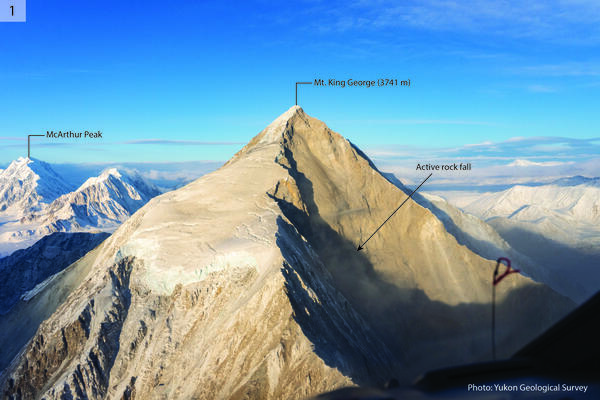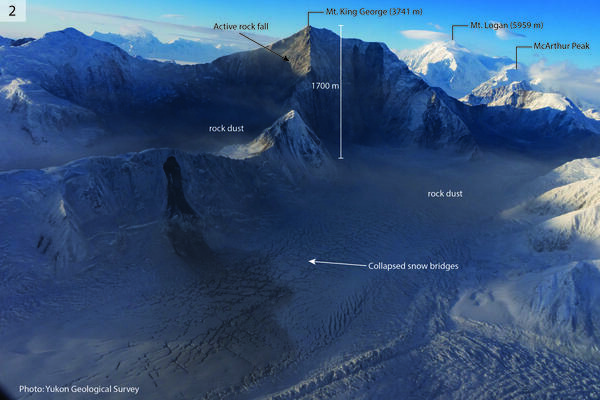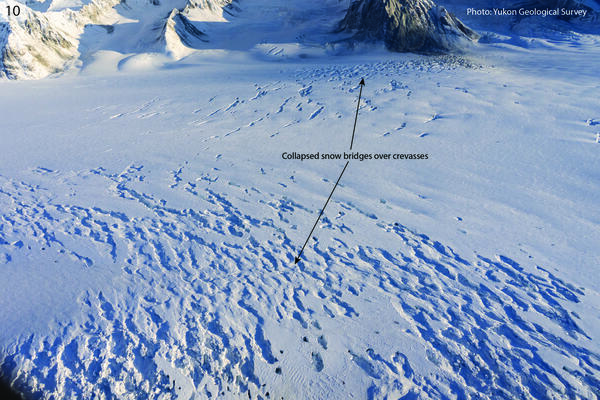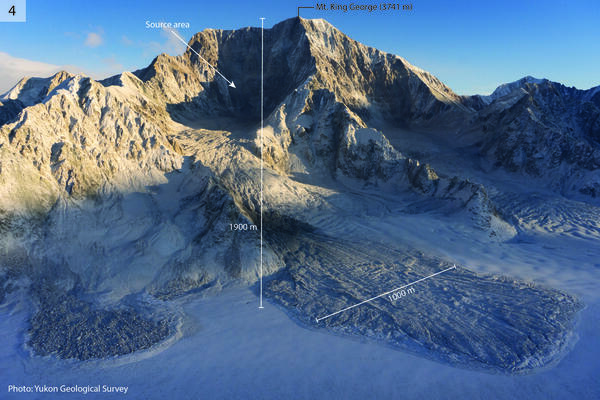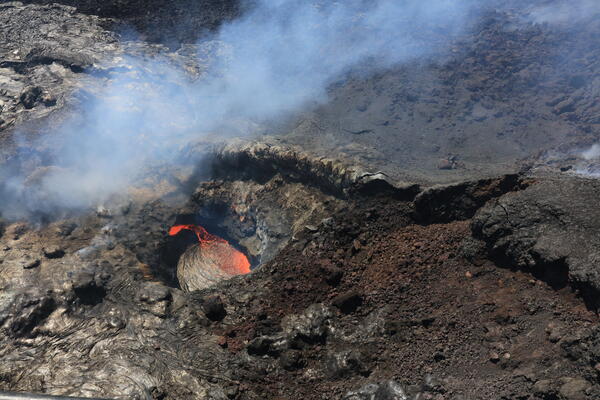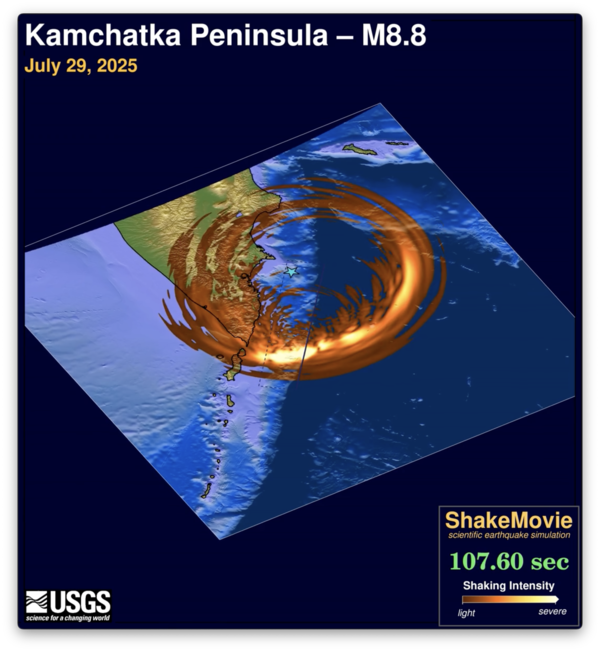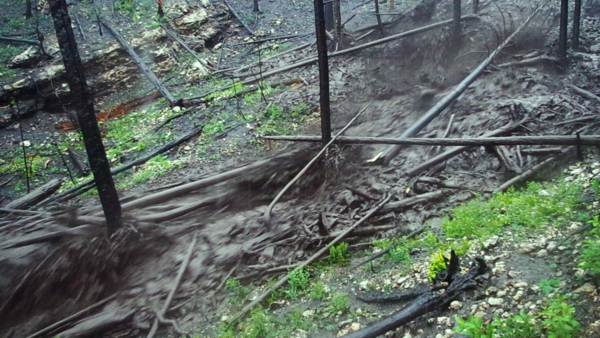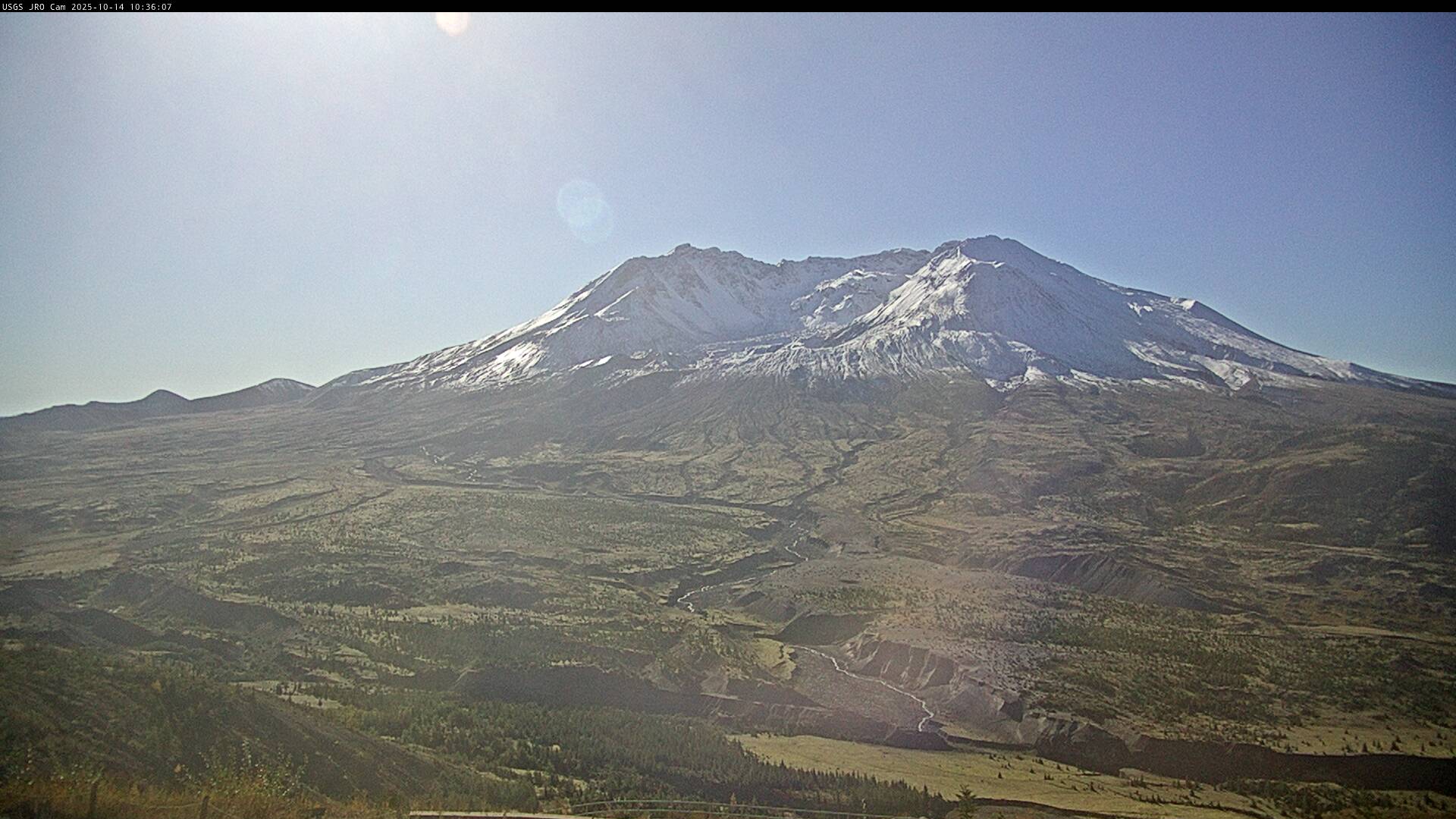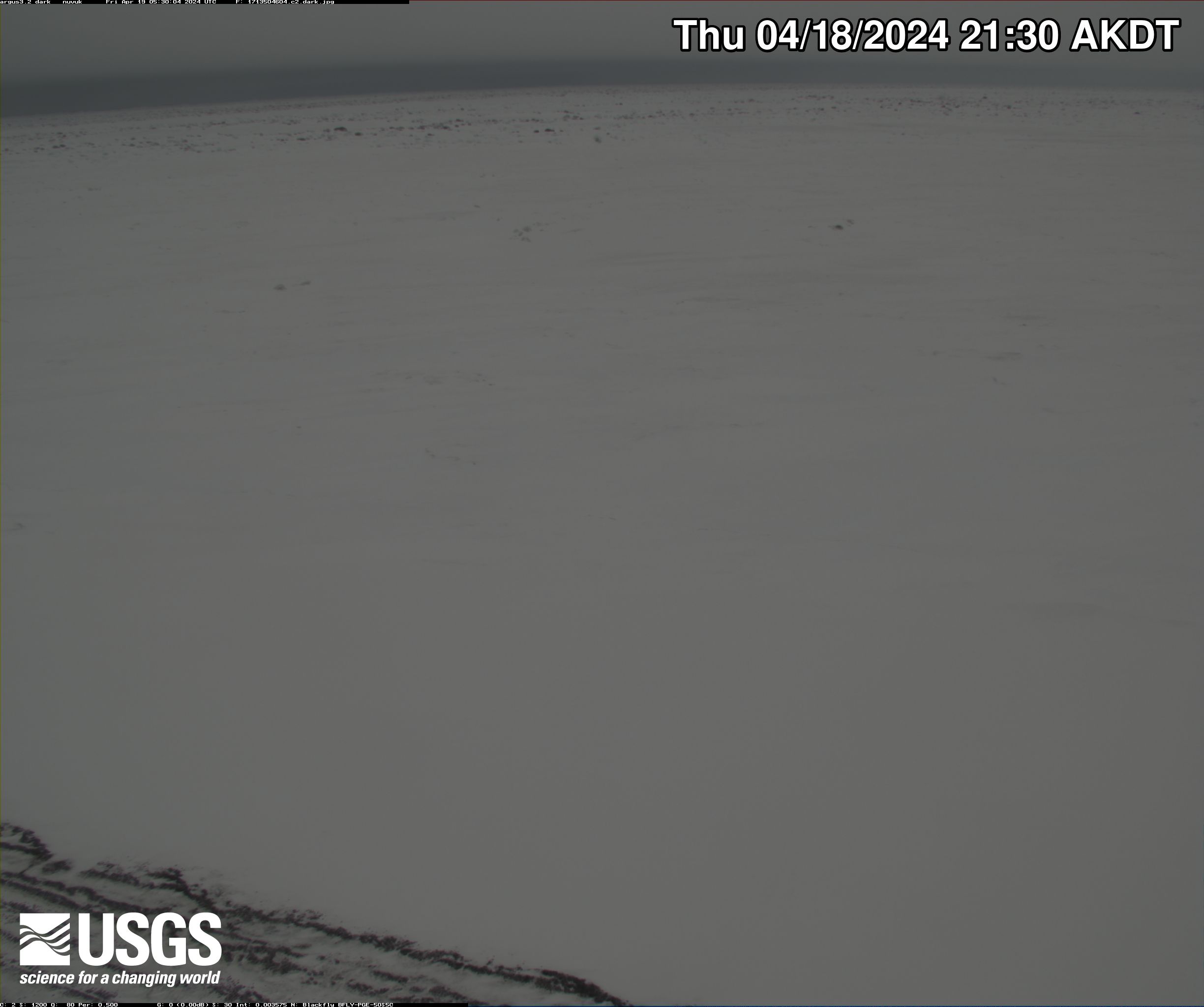Recent landslide on the east face of Mt. King George (3741 m) with clouds of dust from ongoing rockfall. Debris descended over 1500 m to the glacier below. Photo courtesy of Yukon Geological Survey.
Multimedia
Images
Recent landslide on the east face of Mt. King George (3741 m) with clouds of dust from ongoing rockfall. Debris descended over 1500 m to the glacier below. Photo courtesy of Yukon Geological Survey.
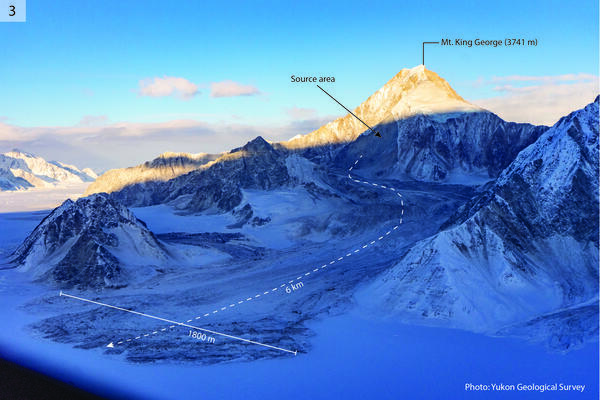
12-12-25 Mt. King George Landslide with Large Runout
12-12-25 Mt. King George Landslide with Large RunoutLarge landslide on the southwest side of Mt. King George. The main debris lobe is 1800 m wide, and material would have travelled approximately 6 km from the source area (triangular scar) in the background. Photo courtesy of Yukon Geological Survey.
12-12-25 Mt. King George Landslide with Large Runout
12-12-25 Mt. King George Landslide with Large RunoutLarge landslide on the southwest side of Mt. King George. The main debris lobe is 1800 m wide, and material would have travelled approximately 6 km from the source area (triangular scar) in the background. Photo courtesy of Yukon Geological Survey.
Landslides on the northeast side of Mt. King George with clouds of rock dust in the air caused by ongoing activity. Elevation difference between the peak and the glacier is at least 1700 m. Also note the numerous collapsed snow bridges on the glacier. Photo courtesy of Yukon Geological Survey.
Landslides on the northeast side of Mt. King George with clouds of rock dust in the air caused by ongoing activity. Elevation difference between the peak and the glacier is at least 1700 m. Also note the numerous collapsed snow bridges on the glacier. Photo courtesy of Yukon Geological Survey.
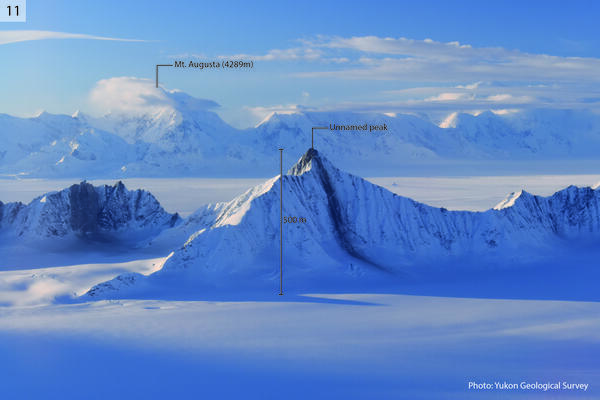
12-12-25 Mt. Vancouver and Mt. Logan Arete Landslides
12-12-25 Mt. Vancouver and Mt. Logan Arete LandslidesCollapsed snow bridges on crevasse field on the Hubbard Glacier between McArthur Peak and Mt. King George. Photo courtesy of Yukon Geological Survey.
12-12-25 Mt. Vancouver and Mt. Logan Arete Landslides
12-12-25 Mt. Vancouver and Mt. Logan Arete LandslidesCollapsed snow bridges on crevasse field on the Hubbard Glacier between McArthur Peak and Mt. King George. Photo courtesy of Yukon Geological Survey.
Collapsed snow bridges on crevasse field on the Hubbard Glacier between McArthur Peak and Mt. King George. Photo courtesy of Yukon Geological Survey.
Collapsed snow bridges on crevasse field on the Hubbard Glacier between McArthur Peak and Mt. King George. Photo courtesy of Yukon Geological Survey.
Large landslides on the southwest side of Mt. King George. The main debris lobe on the right is approximately 1000 m wide. The elevation difference between the peak and the glacier is approximately 1900 m. Photo courtesy of Yukon Geological Survey.
Large landslides on the southwest side of Mt. King George. The main debris lobe on the right is approximately 1000 m wide. The elevation difference between the peak and the glacier is approximately 1900 m. Photo courtesy of Yukon Geological Survey.
Videos
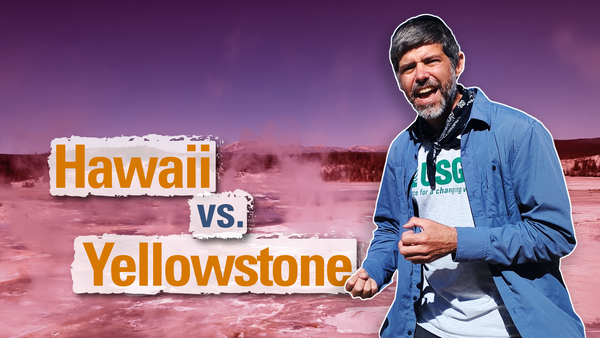 Thumbnail image of a man speaking in front of a desolate Yellowstone thermal basin
Thumbnail image of a man speaking in front of a desolate Yellowstone thermal basin
Hawaii versus Yellowstone (Yellowstone monthly update - December 2025)
Hawaii versus Yellowstone (Yellowstone monthly update - December 2025)Just last week, Kīlauea put on another dramatic display of lava fountaining and flows within the caldera, during its 37th episode of this most recent eruption. It doesn't seem like Hawaii and Yellowstone have a lot in common, but actually, those two magmatic systems have a common cause.
Hawaii versus Yellowstone (Yellowstone monthly update - December 2025)
Hawaii versus Yellowstone (Yellowstone monthly update - December 2025)Just last week, Kīlauea put on another dramatic display of lava fountaining and flows within the caldera, during its 37th episode of this most recent eruption. It doesn't seem like Hawaii and Yellowstone have a lot in common, but actually, those two magmatic systems have a common cause.
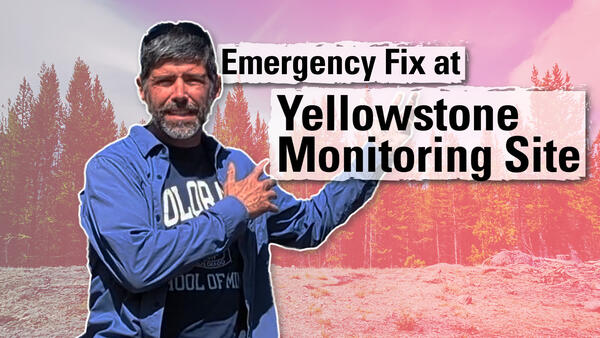 Thumbnail image of a man gesturing towards trees in the background
Thumbnail image of a man gesturing towards trees in the background
Emergency fix at a Yellowstone monitoring site (Yellowstone Monthly Update October 2025)
Emergency fix at a Yellowstone monitoring site (Yellowstone Monthly Update October 2025)The Yellowstone caldera is vast – 45 miles across by 30 miles wide. You could fit over 60 islands of Manhattan in this area. There are deep canyons, like the one on the Yellowstone River, that reveal a complex geologic history. And, forested landscapes and features remind us that this special place is ever-changing.
Emergency fix at a Yellowstone monitoring site (Yellowstone Monthly Update October 2025)
Emergency fix at a Yellowstone monitoring site (Yellowstone Monthly Update October 2025)The Yellowstone caldera is vast – 45 miles across by 30 miles wide. You could fit over 60 islands of Manhattan in this area. There are deep canyons, like the one on the Yellowstone River, that reveal a complex geologic history. And, forested landscapes and features remind us that this special place is ever-changing.
During a USGS Hawaiian Volcano Observatory helicopter overflight on the morning of August 5, geologists observed a lava pond within the north vent of the ongoing Kīlauea summit eruption. The pond was feeding a subterranean lava tube contained within the east side of the vent cone, toward the floor of Halema‘uma‘u crater.
During a USGS Hawaiian Volcano Observatory helicopter overflight on the morning of August 5, geologists observed a lava pond within the north vent of the ongoing Kīlauea summit eruption. The pond was feeding a subterranean lava tube contained within the east side of the vent cone, toward the floor of Halema‘uma‘u crater.
Shakemovie animation showing seismic waves emanating from the magnitude 8.8 Kamchatka Peninsula earthquake.
Shakemovie animation showing seismic waves emanating from the magnitude 8.8 Kamchatka Peninsula earthquake.
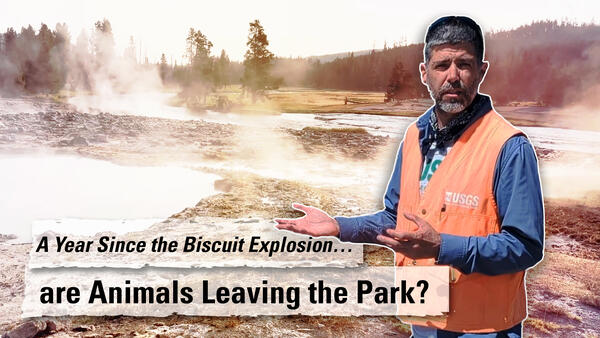 Thumbnail showing man in orange vest in front of a steaming geyser basin
Thumbnail showing man in orange vest in front of a steaming geyser basin
A year since the Biscuit explosion… are animals leaving the park? (Yellowstone Monthly Update August 2025)
A year since the Biscuit explosion… are animals leaving the park? (Yellowstone Monthly Update August 2025)Just over one year ago, early morning visitors to Yellowstone’s Black Diamond Pool suddenly found themselves filming a spectacular event. The July 23, 2024 hydrothermal explosion threw material hundreds of feet high, including rocks that were a foot or more across.
A year since the Biscuit explosion… are animals leaving the park? (Yellowstone Monthly Update August 2025)
A year since the Biscuit explosion… are animals leaving the park? (Yellowstone Monthly Update August 2025)Just over one year ago, early morning visitors to Yellowstone’s Black Diamond Pool suddenly found themselves filming a spectacular event. The July 23, 2024 hydrothermal explosion threw material hundreds of feet high, including rocks that were a foot or more across.
Postfire debris flow in the 2024 Elk Fire burn area
Postfire debris flow in the 2024 Elk Fire burn areaA debris flow recorded by a USGS Landslide Monitoring Station in the 2024 Elk Fire burn area near Dayton, Wyoming. The flow was triggered by intense rainfall during a thunderstorm on the evening of July 15, 2025.
Postfire debris flow in the 2024 Elk Fire burn area
Postfire debris flow in the 2024 Elk Fire burn areaA debris flow recorded by a USGS Landslide Monitoring Station in the 2024 Elk Fire burn area near Dayton, Wyoming. The flow was triggered by intense rainfall during a thunderstorm on the evening of July 15, 2025.
Audio
USGS scientists remember where they were during the 1992 Landers earthquake in Southern California
USGS scientists remember where they were during the 1992 Landers earthquake in Southern California
USGS seismologist Susan Hough recalls what the 1992 Landers earthquake felt like from Pasadena, CA.
USGS seismologist Susan Hough recalls what the 1992 Landers earthquake felt like from Pasadena, CA.
Landers Rupture — Sue on her role after the earthquake and seismic monitoring in Southern CA
Landers Rupture — Sue on her role after the earthquake and seismic monitoring in Southern CAUSGS seismologist Susan Hough talks about her role following the 1992 Landers earthquake and seismic monitoring stations in Southern California.
Landers Rupture — Sue on her role after the earthquake and seismic monitoring in Southern CA
Landers Rupture — Sue on her role after the earthquake and seismic monitoring in Southern CAUSGS seismologist Susan Hough talks about her role following the 1992 Landers earthquake and seismic monitoring stations in Southern California.
USGS field technician Scott Lydeen recalls what the aftermath of the 1992 Landers earthquake looked like.
USGS field technician Scott Lydeen recalls what the aftermath of the 1992 Landers earthquake looked like.
Landers Rupture — Sue on how monitoring networks evolved
Landers Rupture — Sue on how monitoring networks evolvedUSGS seismologist Susan Hough described the Southern California Seismic Network and how it was used for the 1992 Landers earthquake.
Landers Rupture — Sue on how monitoring networks evolved
Landers Rupture — Sue on how monitoring networks evolvedUSGS seismologist Susan Hough described the Southern California Seismic Network and how it was used for the 1992 Landers earthquake.
USGS seismologist Andrew Michael talks about the remote location of the 1992 Landers earthquake and how researchers were able to use satellite data to better see the quake’s impacts.
USGS seismologist Andrew Michael talks about the remote location of the 1992 Landers earthquake and how researchers were able to use satellite data to better see the quake’s impacts.
Webcams
A coastal camera located on Medeira Beach, Florida near the Shoreline Island Resort.
A coastal camera located on Medeira Beach, Florida near the Shoreline Island Resort.
This static image is from a USGS Cascades Volcano Observatory research camera located at the Johnston Ridge Observatory, north of Mount St. Helens. The view is to the south. This camera is intended to assist the USGS with situational awareness. At times, clouds, rain, and snow obscure visibility.
This static image is from a USGS Cascades Volcano Observatory research camera located at the Johnston Ridge Observatory, north of Mount St. Helens. The view is to the south. This camera is intended to assist the USGS with situational awareness. At times, clouds, rain, and snow obscure visibility.

Most recent snapshot at Madeira Beach, Florida, Camera 2
Most recent snapshot at Madeira Beach, Florida, Camera 2Most recent snapshot from Camera 2 at Madeira Beach, Florida. Camera hosted by Shoreline Island Resort.
Most recent snapshot at Madeira Beach, Florida, Camera 2
Most recent snapshot at Madeira Beach, Florida, Camera 2Most recent snapshot from Camera 2 at Madeira Beach, Florida. Camera hosted by Shoreline Island Resort.
Two video cameras are installed atop a utility pole near the northernmost point of land in the United States at Nuvuk (Point Barrow), Alaska. The cameras point northwest toward the Arctic Ocean and the boundary between the Chukchi and Beaufort Seas. Every half hour during daylight hours, the cameras collect snapshots and video for 10 minutes.
Two video cameras are installed atop a utility pole near the northernmost point of land in the United States at Nuvuk (Point Barrow), Alaska. The cameras point northwest toward the Arctic Ocean and the boundary between the Chukchi and Beaufort Seas. Every half hour during daylight hours, the cameras collect snapshots and video for 10 minutes.
Two video cameras are installed atop a utility pole near the northernmost point of land in the United States at Nuvuk (Point Barrow), Alaska. The cameras point northwest toward the Arctic Ocean and the boundary between the Chukchi and Beaufort Seas. Every half hour during daylight hours, the cameras collect snapshots and video for 10 minutes.
Two video cameras are installed atop a utility pole near the northernmost point of land in the United States at Nuvuk (Point Barrow), Alaska. The cameras point northwest toward the Arctic Ocean and the boundary between the Chukchi and Beaufort Seas. Every half hour during daylight hours, the cameras collect snapshots and video for 10 minutes.
Two video cameras are installed atop a utility pole near the northernmost point of land in the United States at Nuvuk (Point Barrow), Alaska. The cameras point northwest toward the Arctic Ocean and the boundary between the Chukchi and Beaufort Seas. Every half hour during daylight hours, the cameras collect snapshots and video for 10 minutes.
Two video cameras are installed atop a utility pole near the northernmost point of land in the United States at Nuvuk (Point Barrow), Alaska. The cameras point northwest toward the Arctic Ocean and the boundary between the Chukchi and Beaufort Seas. Every half hour during daylight hours, the cameras collect snapshots and video for 10 minutes.


